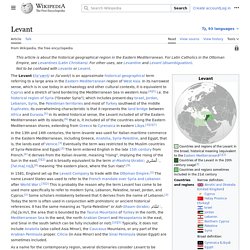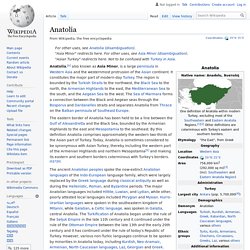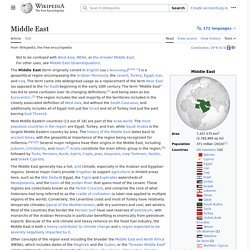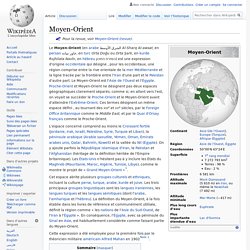

Kurdistan. Un article de Wikipédia, l'encyclopédie libre.

Le Kurdistan (signifiant littéralement « pays des Kurdes[1] » ; en kurde : Kurdewarî ou simplement Kurdistan (ce dernier étant plus usité), anciennement transcrit Gordyène ou Kardouchi, est une région géographique et culturelle d'Asie occidentale, majoritairement peuplée par les Kurdes. Cette région s'étend dans le sud-est de la Turquie, dans le nord-est de l'Irak, dans le nord-ouest de l'Iran et sur deux petites régions au nord-est et au nord-ouest de la Syrie[1]. Sur ces quatre pays, seuls deux reconnaissent officiellement une région sous la dénomination de « Kurdistan » : l'Iran avec sa province du Kurdistan et l'Irak avec sa région autonome du Kurdistan[1]. Étymologie[modifier | modifier le code] La région du Kurdistan est connue par plusieurs termes apparentés au mot Kurde au cours de l'Antiquité.
La terminaison en -stan dans le mot Kurdistan est un suffixe utilisé par les langues iraniennes signifiant « pays de ». Chypre du Nord. Un article de Wikipédia, l'encyclopédie libre.

Pour les articles homonymes, voir Chypre. République turque de Chypre du Nord Kuzey Kıbrıs Türk Cumhuriyeti (tr) Τουρκική Δημοκρατία της Βόρειας Κύπρου (el) Toutefois, depuis 2004, l'Organisation de la conférence islamique accorde à l’État turc de Chypre du Nord le statut d'observateur sous le nom d'« État turc de Chypre ».
Péninsule Arabique. Levant. The term entered English in the late 15th century from French.[3] It derives from the Italian Levante, meaning "rising", implying the rising of the sun in the east.[2][4] As such, it is broadly equivalent to the term Al-Mashriq (Arabic: اَلْـمَـشْـرِق, [ʔalmaʃriq])[5], meaning "the land where the sun rises".

The Levant has been described as the "crossroads of western Asia, the eastern Mediterranean, and northeast Africa",[19] and the "northwest of the Arabian plate".[20] The populations of the Levant[21][22] share not only the geographic position, but cuisine, some customs, and a very long history. They are often referred to as Levantines.[23] Etymology The notion of the Levant has undergone a dynamic process of historical evolution in usage, meaning, and understanding. While the term "Levantine" originally referred to the European residents of the eastern Mediterranean region, it later came to refer to regional "native" and "minority" groups.[27] Geography and modern-day use of the term.
Mesopotamia. Map showing the extent of Mesopotamia Mesopotamia (from the Ancient Greek: Μεσοποταμία: "[land] between rivers"; Arabic: بلاد الرافدين (bilād al-rāfidayn); Syriac: ܒܝܬ ܢܗܪܝܢ (Beth Nahrain): "land of rivers") is a name for the area of the Tigris–Euphrates river system, corresponding to modern-day Iraq, Kuwait, the northeastern section of Syria and to a much lesser extent southeastern Turkey and smaller parts of southwestern Iran.

Widely considered to be the cradle of civilization in the West, Bronze Age Mesopotamia included Sumer and the Akkadian, Babylonian, and Assyrian empires, all native to the territory of modern-day Iraq. In the Iron Age, it was controlled by the Neo-Assyrian and Neo-Babylonian empires. The indigenous Sumerians and Akkadians (including Assyrians and Babylonians) dominated Mesopotamia from the beginning of written history (c. 3100 BC) to the fall of Babylon in 539 BC, when it was conquered by the Achaemenid Empire.
Etymology Geography History Periodization Literature. Anatolia. Anatolia (from Greek: Ἀνατολή, Anatolḗ, "east" or "[sun]rise"; Turkish: Anadolu), also known as Asia Minor (Medieval and Modern Greek: Μικρά Ἀσία, Mikrá Asía, "small Asia"; Turkish: Küçük Asya), Asian Turkey, the Anatolian peninsula or the Anatolian plateau, is a large peninsula in West Asia and the westernmost protrusion of the Asian continent.

It makes up the majority of modern-day Turkey. Iran. Country in the Middle East Coordinates: 32°N 53°E / 32°N 53°E / 32; 53 Iran (Persian: ایران Irān [ʔiːˈɾɒːn] ( listen)), also called Persia,[10] and officially the Islamic Republic of Iran (Persian: جمهوری اسلامی ایران Jomhuri-ye Eslāmi-ye Irān ( listen) [dʒomhuːˌɾije eslɒːˌmije ʔiːˈɾɒn]), is a country in Western Asia.[11][12] It is bordered to the northwest by Armenia and Azerbaijan,[a] to the north by the Caspian Sea, to the northeast by Turkmenistan, to the east by Afghanistan, to the southeast by Pakistan, to the south by the Persian Gulf and the Gulf of Oman, and to the west by Turkey and Iraq.

Iran is home to one of the world's oldest civilizations,[16][17] beginning with the formation of the Elamite kingdoms in the fourth millennium BC. Middle East. The Middle East[note 1] (also called the Mid East) is a eurocentric description of a transcontinental region centered on Western Asia and Egypt.

Moyen-Orient. Cet espace abrite plusieurs groupes culturels et ethniques, incluant la culture perse, turque, arabe, kurde et juive.

Les trois principaux groupes linguistiques sont les langues iraniennes, les langues turques et les langues sémitiques (dont l'arabe, l'amharique et l'hébreu). La définition du Moyen-Orient, à la fois établie dans les livres de référence et communément utilisée, définit la région comme « les nations de l'Asie du Sud-Ouest, de l'Iran à l'Égypte ». En conséquence, l'Égypte, avec sa péninsule du Sinaï en Asie, est habituellement considérée comme faisant partie du Moyen-Orient. Cette expression a été employée pour la première fois par le théoricien militaire américain Alfred Mahan en 1902[Note 1]. Étymologie[modifier | modifier le code] Noms[modifier | modifier le code] Le qualificatif de « Moyen » a entraîné certaines confusions au-delà du problème actuel de définition de l'espace situé entre le monde indien et l'Europe.